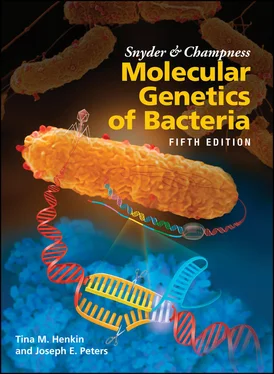The archaea(formerly called archaebacteria) are single-celled organisms that resemble bacteria. Bacteria and archaea were previously considered one group called the prokaryotes, which means “before the nucleus,” and are still sometimes referred to by this name. However, there are hazards with this designation, as it erroneously implies that bacteria and archaea are more closely related to each other than they are to eukaryotes (see below). The term “prokaryote” also tends to obscure the idea that present-day bacteria and archaea have had as much time to evolve as eukaryotes since they separated and so did not “come before.” Bacteria and archaea do lack a nucleus, the defined membrane structure found in eukaryotes that houses the vast majority of the genes of the organism. The presence or absence of a nuclear membrane greatly influences the mechanism used to manufacture proteins in the cell. The processes of messenger RNA (mRNA) synthesis and translation are coupled in bacteria and archaea, since no nuclear membrane separates the ribosomes (which synthesize proteins) from the DNA (see chapter 2). However, in most eukaryotes, mRNA made in the nucleus must be transported through the nuclear membrane before it can be translated into protein in the cytoplasm, where the ribosomes reside, and transcription and translation do not occur simultaneously.
Besides lacking a nucleus, bacterial and archaeal cells lack many other cellular constituents common to eukaryotes, including mitochondria and chloroplasts. They also lack such visible organelles as the Golgi apparatus and the endoplasmic reticulum. While bacteria can possess compartmentalized features for a wide variety of purposes such as the storage of carbon and nutrients and for specialized enzymatic processes, the absence of most organelles generally gives bacterial and archaeal cells a much simpler appearance under the microscope than eukaryotes.
Extremophiles (or “extreme-condition-loving” organisms), as their name implies, live under extreme conditions where other types of organisms cannot survive, such as at very high temperatures, in highly acidic environments, and at very high osmolality, such as in the Dead Sea. Most extremophiles are archaea. However, it is becoming clear that archaea also are important components of many less extreme environments; for example, archaea perform unique biochemical functions, such as making methane, and can be normal inhabitants of the human microbiome.
The archaea themselves are a very diverse group of organisms, and our understanding of the phylogeny of archaea is an area of intense research that is currently in flux. One exciting update to our understanding is that it is now clear that eukaryotes branch out of the archaea and, more specifically, out of the TACK superphylum ( Thaumarchaeota , Aigarchaeota , Crenarchaeota , and Korarchaeota ). Perhaps the most exciting area of research involves the discovery of uncultured archaeal lineages like the Lokiarchaeota that possess numerous molecular systems that were previously only associated with eukaryotes, providing a clear link bet ween archaea and eukaryotes (see Spang et al., Suggested Reading). Excitingly, an archaeon that appears to be on the border between prokaryotes and eukaryotes has now been isolated and is pictured at the start of this chapter (see Imachi et al., Suggested Reading). The relationship between the superphylum TACK archaea and two other large divisions with the archaea, the Euryarchaeota and the superphylum DPANN ( Diapherotrites , Parvarchaeota , Aenigmarchaeota , Nanoarchaeota , and Nanohaloarchaeota ), is currently under investigation. While the basic molecular processes of archaea are an active area of investigation, much less is known about the archaea than about the bacteria.
The eukaryotesare members of the third domain of organisms on Earth, which branches out of the archaea. This domain includes organisms as variable as plants, animals, fungi, and the highly diverse protists. The name “eukaryote” is derived from the presence of their nuclear membrane. Eukaryotic cells usually have a nucleus, and the word karyon in Greek means “nut,” which is what the nucleus must have resembled to early cytologists. The eukaryotes can be unicellular, like yeasts, protozoans, and some types of algae, or they can be multicellular, like plants and animals. In spite of their widely diverse appearances, lifestyles, and relative complexity, however, all eukaryotes are remarkably similar at the biochemical level, particularly in their pathways for macromolecular synthesis.
MITOCHONDRIA AND CHLOROPLASTS AND THE ROLE OF ENDOSYMBIOSIS IN EVOLUTION
Essentially all eukaryotic cells contain something, the mitochondria, that ties them to the world of bacteria. The mitochondria of eukaryotic cells are the sites of efficient adenosine triphosphate (ATP) generation through respiration. Evidence, including the sequences of many genes in their rudimentary chromosomes, indicates that the mitochondria of eukaryotes are descended from free-living bacteria from the Alphaproteobacteria that formed a symbiosis with a primitive ancestor of eukaryotes. A specialized type of symbiosis, where the symbiont resides entirely within another organism, is called endosymbiosis.
Plant cells and some unicellular eukaryotic cells also contain chloroplasts, the site of photosynthesis. Like mitochondria, chloroplasts are also descended from free-living bacteria, in this case Cyanobacteria . Mitochondria and chloroplasts resemble bacteria in many ways. For instance, they contain DNA that encodes the components of oxidative phosphorylation and photosynthesis, as well as rRNAs and transfer RNAs (tRNAs). Even more striking, the mitochondrial and chloroplast rRNA and ribosomal proteins, as well as the membranes of the organelles, more closely resemble those of bacteria than they do those of eukaryotes. Comparisons of the sequences of highly conserved organelle genes, like the rRNAs, with those of bacteria also support this view of chloroplasts and mitochondria (see Yang et al., Suggested Reading).
Mitochondria and chloroplasts may have come to be associated with early eukaryotic/archaeal cells when these cells engulfed bacteria to take advantage of their superior energy-generating systems or their ability to obtain energy from light through photosynthesis. The engulfed bacteria eventually lost many of their own genes, which moved to the chromosome, from where they are expressed and their products are transported back into the organelle. The organelles had by then lost their autonomy and had become permanent endosymbionts of the eukaryotic cells. In one view, the role of endosymbiosis in the evolution of eukaryotes calls into quest ion the use of phylogenetic trees as a tool to describe the interrelationship of entire organisms, given that many organisms represent a conglomeration of genomes (see Koonin, Suggested Reading).
Interestingly, members of a large newly identified group within bacteria with no cultured representatives, called the Candidate Phyla Radiation ( Figure 1), have relatively small genomes and, to varying degrees, limited metabolic capacities. This has led to the idea that many of these lineages may be symbionts, something that has been shown in some cases.
Geneticscan be simply defined as the manipulation of DNA to study cellular and organismal functions. Since DNA encodes all of the information needed to make the cell and the complete organism, the effects of changes in DNA can give clues to the normal functions of the cell and organism.
Читать дальше











